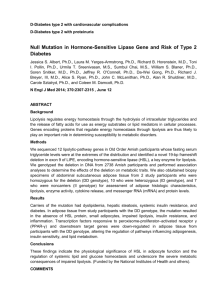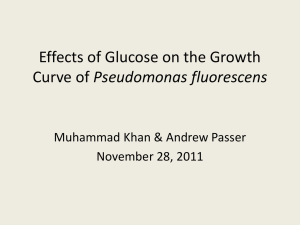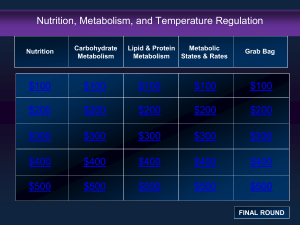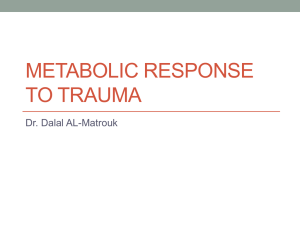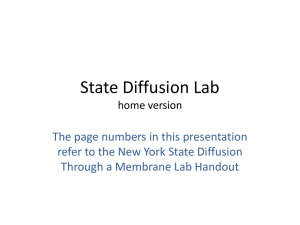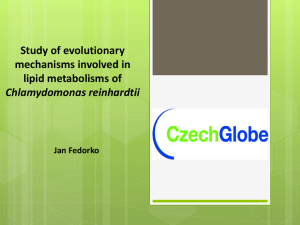Metabolic Support in the ICU
advertisement
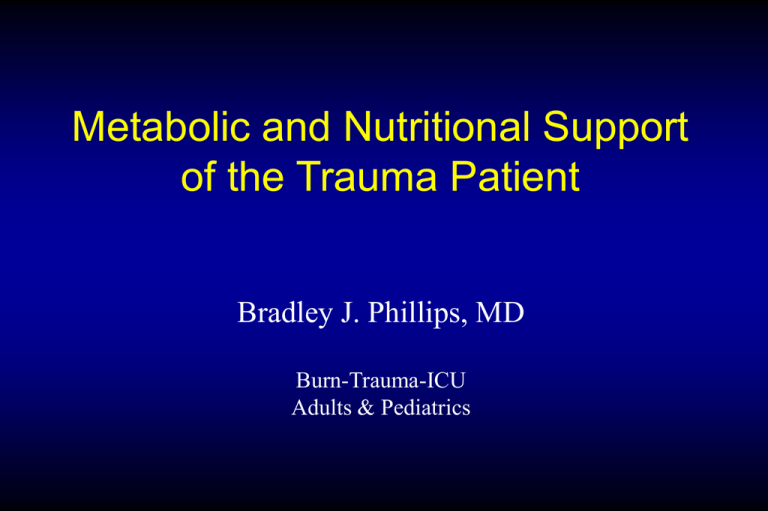
Metabolic and Nutritional Support of the Trauma Patient Bradley J. Phillips, MD Burn-Trauma-ICU Adults & Pediatrics Historical Prospective (Metabolic and Nutritional Support) • “Starve a fever, feed a cold” • 300 BC ,100 AD - Aristotle, Galen -” vital heat “ 1600’s Harvey, Van Helmont - heat related to circulation, heat is lost due to death 1920’s Cuthbertson - hypermetabolic response to injury Metabolic response to injury The metabolic responses to critical illness /trauma evolve over time Metabolic needs reflexed the phase of the injury response Phases of the injury response : ebb,flow, convalescence Ebb phase: 24 - 48 hrs fluid retention elevated counter Regulator hormones glycogenolysis, Lipolysis EBB phase – Decrease cardiac output – Decrease oxygen consumption – Decrease temperature – Increase blood sugar, lactate levels, normal to low Insulin levels Flow phase: - Post ebb ,variable time course – Hypermetabolic – muscle catabolism – Hyperglycemia – Elevated Free fatty acids Flow phase • • • • Increase cardiac output Increase body temperature Increase 02 consumption Increase blood sugar, Insulin Convalescence / Recovery Phase: – weeks to months – anabolic – decrease in total body edema, – return of GI function – weight gain Metabolic Response to Injury • Substrate mobilization: – mixed fuel of glucose,protein and Lipid. • Glucose via glycogen then hepatic and renal gluconeogenesis. (lactate, glycerol, alanine). • Protein from peripheral stores to provide alanine and substrates for hepatic acute phase proteins. • Lipid mobilized from peripheral stores via lipolysis to generate free fatty acids and glycerol. Neuroendocrine Response to Injury Counter Regulatory hormones Glucagon Epinephrine Norepinephrine Growth hormone Cortisol Cytokine Cascade – Releases from multiple cell types after injury or infection. • TNF IL-1 and IL-6. • IL-1 > TNF, IL-6 stimulate pituitary adrenal axis. • Glucocorticoids inhibit cytokine release, reduces cytokine MRNA. Neuroendocrine/Cytokine Response to Injury • Stimuli – Hemorrhage, ECF loss – Hypoxemia – Pain/anxiety – Change in temperature – Change in substrate availability – Tissue injury Injury/Stress : Carbohydrate metabolism – glycogenolysis – gluconeogenesis – increase liver production and peripheral uptake – insulin residence – hyperglycemia Carbohydrate Metabolism in stress HORMONES: counter - regulatory Glucagon, epinephrine, norepinephrine cortisol - counter act hypoglycemia Epinephrine - glycogenolysis, gluconeogenesis glucagon Glucagon - liver production of glucose, dose not effect clearance Insulin - production from B cells, resistance Postreceptor Cortisol potentiates other hormones effects glucose,AA and Fatty acid metabolism Carbohydrate Metabolism in Stress Cytokines: TNF - hepatic glucose productions, glucose uptake in peripheral tissue IL - 1 - plasma glucose - hepatic production peripheral glucose transport Injury/stress : Protein metabolism – Protein catabolism – Protein synthesis is up, but the net rate of brake down is greater. – AA mobilized from skeletal muscle to fuel wound healing , the cellular inflammatory response and acute phase protein production, AA oxidized for fuel – Protein catabolism poorly suppressed by exogenous fuels Protein Metabolism in stress Hormones - muscle counter regulatory hormones increase muscle protein brake down Cortisol,glucagon and catecholamines muscle breakdown GH/IGF-1 - levels in stress anabolic Insulin - inhibits protein break down - Protein metabolism in Stress Hormones - liver – epinephrine - APP, AA transport – glucagon - APP, AA transport – cortisol - AA, enhance other hormone,cytokine effects – GH - AA transport Protein Metabolism in Stress – CYTOKINES: – TNF, IL-I - increase protein breakdown in muscle, may inhabit effects of IGF - 1 – IL-6 - APP production as do IL-I, TNF,IFN – Cytokines and hormones interact to effect protein synthesis in the liver and protein breakdown in muscle Injury/Stress : Lipid metabolism – Increases fat metabolism ,increased serum FFA,Triglycerides – clearance of triglycerides, lipoprotein lipase activity – Lipolysis – Synthesis of liver Apolipoproteins and triglycerides - denovo + recycled FFA Lipid Metabolism in stress – HORMONES: – Effect of counter regulator hormones on lipid metabolism unclear – Epinephrine Lipolysis in adipose tissue – Glucagon - FA synthesis in the liver – Cortisol - FA synthesis in adipose tissue does not effect liver FA synthesis – Insulin - FA synthesis in hepatocyte Lipid Metabolism in Stress Cytokines: TNF - serum triglycerides - hepatic FFA and triglyceride synthesis, Lipolysis in adipose tissue serum FFA; glycerol IL-1, IFN-’s - Lipolysis, Lipoprotein Lipase :effect many aspects of hepatic Fatty acid synthesis Metabolic Response to Injury • Substrate mobilization: – mixed fuel of glucose,protein and Lipid. • Glucose via glycogen then hepatic and renal gluconeogenesis. (lactate, glycerol, alanine). • Protein from peripheral stores to provide alanine and substrates for hepatic acute phase proteins. • Lipid mobilized from peripheral stores via lipolysis to generate free fatty acids and glycerol. Metabolic Response to Injury Ebb phase - fuel mobilization Flow phase - catabolic Convalescence - anabolic Counter Regulatory hormones Cytokines TNF,IL-1 and IL-6. Nutritional Assessment Nutritional Assessment • Who to feed ? • When and How to feed ? • What to feed ? Nutritional Assessment • Who to feed ? • Only those patients who will benefit • Only those patients whose risks of complications from malnutrition are greater then the risks of nutritional interventions Nutritional Assessment • Who to feed ? • Malnourished patients > 10% Wgt. Lose. • NPO > 5-7 days. • Patient expected to be NPO > 7-10 days. Nutritional Support • How: – Use the gut. – It’s natural. – Protects the patient from the TPN Doctor. Nutrient Composition • What to feed ? • How much energy ? Hypermetabolism of Injury • Major surgery 10% > baseline. • Trauma 25% > baseline. • Large burn injury 100% > baseline. Energy Requirements of Injury • Measured need : indirect calorimetry – E.E. = (3.94 x VO2 ) + (1.1 x VCO2 ) • Estimated energy needs: Harris-Benedict • men: EE= 66+(13.8xwgt) + (5xHt) -(6.8xage) • women: EE= 665+ (9.6xwgt) + (1.7xHt) (4.7xAge) • 25kcal/Kg/day. • Indirect calorimetry Metabolic cart Indirect Calorimetry Metabolic cart in critical illness • Resting energy expenditure of critically ill patients varies widely over the course of the day and over the course of an illness • Measurements from - 10 % to + 23 % of an “average” REE can be seen within a 24 hour period Indirect Calorimetry Predicting REE Harris-Benedict is correct 80-90% of the time in healthy, normal volunteers. In 10-14% it over estimates EE In obese normal volunteers it predicts EE correctly in only 40-64% in critically ill patients the Harris-Benedict equation is correct only 50% of the time For most disease processes Harris -Benedict underestimates EE Indirect Calorimetry Predicting REE Multipliers for various disease states attempt to improve the accuracy of the Harris-Benedict equation These multipliers tend to overestimate EE when compared to indirect calorimetry Nutrient Composition - Energy • Complications of under feeding ? – Morbidity and mortality of malnutrition • Complications of over feeding? – Hyperglycemia, fatty liver , respiratory failure, immunosuppression,etc . • 25kcal/Kg/day will avoid over or under feeding of most critically ill patients. Nutrient Composition • What ? • Protein. • Carbohydrate. • Fat. Substrate Provision Protein: metabolic stress leads to; proteolysis of skeletal muscle,increased Hepatic synthesis of APP,increased use of AA for energy production. Net nitrogen lose • 1.5 gram/kg/day. • > 1.4 gram/kg/day leads to both an increase in protein synthesis and catabolism with no net gain for the patient. • Glutamine, Arginine. Substrate Provision • Carbohydrates: – Glucose primary fuel for the injury response. – Injury/stress effect ability to oxidize glucose – Stable post-op patient maximum glucose oxidation rate 7mg/kg/min. – Stressed patient maximum glucose oxidation rate 5mg/kg/min. Substrate Provision • Carbohydrates: – maximum glucose oxidation rate: 5mg/kg/min. – Avoid: over feeding, hyperglycemia (BS < 220 mg/dL). PREVALENCE OF HYYPRGLECEMIA IN TPN PATIENTS • 260 TPN patients screened, 102 low risk patients evaluated . 22 % ( 23/102) of low risk patients had BS > 200mg/dl • Glucose infusion:mg/Kg/min Patients BS > 200 mg/dl Patients BS < 200 mg/dl <4 0 (0 %) 18 Rosemarin DK, et al, Nutri. Clin Pract, 1996;11:151-6 4.1 - 5 5 (11 %) 41 >5 18 (50 %) 19 Substrate Provision • Carbohydrates: – maximum glucose oxidation rate: 5mg/kg/min. Substrate Provision- lipid Lipid: Fat metabolism is increased in stress, increased lipolysis, increased fatty acid oxidation, increased production and release from the liver . Lipid administration prevents essential fatty acid deficiency ,spares protein. Lipid administration has cardiopulmonary and immunologic effects Substrate Provision • Lipids: – Provide EFA’s. – Provide calories that avoid hyperglycemia. – Mixed fuel may enhance protein sparing. – Cardiovascular effects. – Immunologic effects. – giving lipid in low concentrations and slowly <0.1 gr/kg/hr of iv lipid Substrate Provision • Lipids: – Cardiopulmonary effects. Alterations in diffusion,shunting and oxygenation – Immunologic effects. Overload REE system,impair neutrophil chemotaxis, modulate eicosanoid production – Effects can be modulated by : choice of lipid; giving lipid in low concentrations and slowly; <0.11gr/kg/hr of iv lipid Trauma Patients Lipid (n=30) No Lipid (n=27) P Age 33 ± 10 32 ± 9 _ ISS 27 ± 8 30 ± 9 _ Apache II 25 ± 6 22 ± 5 _ On Ventilator* ICU Los* Hospital Los* 27 ± 21 29 ± 22 39 ± 24 15 ± 12 18 ± 12 27 ± 16 Survival Non-protein kcal/kg % kcal as Lipid Amino Acids (g/kg-d) 30/30 29 ± 2 25 ± 4 1.6 ± 0.2 25/27 22 ± 1 0 1.5 ± 0.1 * in days, LOS = length of stay Data expressed means ± SD Battistella et al. J Trauma 39: 164, 1995 0.01 0.02 0.03 Conclusion – N.S. essential to Rx/avoid malnutrition and its complication. – N.S. only helpful for patients at risk and if given correctly. – Avoid over feeding. – Avoid hyperglycemia. – Lipid at low concentrations, given slowly. Nutritional Support • • • • Energy Glucose Protein Lipid - 25 kcal/kg/day Do not exceed 5mg/kg/min 1.5 gr/kg/day Do not exceed 0.11 gr/kg/hr Conclusion – Metabolic response to injury evolve over time . – Responses are under hormonal and cytokine control – Hypermetabolism after injury is variable. – Nitrogen loss, muscle wasting and hyperglycemia. – Outcome from injury can be enhanced by the judicious use of nutritional support. Questions…?

